|
||||||
|
RUBUS. Cloudberry, Brambles, Shrub dewberry and Raspberry. [Rubiaceae] |
|
|
There are eleven species and nearly 400 microspecies of Rubus recorded in Britain, although only six or seven are native, including Cloudberry (R. chamaemorus), Stone Bramble (R. saxatilis) Shrub Dewberry (R. caesius), Bramble (Rubus fruticosus agg.), Raspberry (R. idaeus) and probably Arctic Bramble (R. arcticus). Cloudberry (R. chamaemorus) is protected in Northern Ireland under Schedule 8 of the Wildlife (Northern Ireland) Order, 1985. Twenty British miners are recorded on Rubus. A key to the European miners recorded on Rubus is provided in Bladmineerders van Europa. |
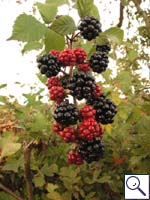 Bramble/Blackberry Rubus fruticosus agg. |
Key for the identification of the known mines of British |
Note: Diptera larvae may live in a corridor mine, a corridor-blotch mine, or a blotch mine, but never in a case, a rolled or folded leaf, a tentiform mine or sandwiched between two more or less circular leaf sections in later instars. Pupation never in a cocoon. All mining Diptera larvae are leg-less maggots without a head capsule (see examples). They never have thoracic or abdominal legs. They do not have chewing mouthparts, although they do have a characteristic cephalo-pharyngeal skeleton (see examples), usually visible internally through the body wall. The larvae lie on their sides within the mine and use their pick-like mouthparts to feed on plant tissue. In some corridor miners frass may lie in two rows on alternate sides of the mine. In order to vacate the mine the fully grown larva cuts an exit slit, which is usually semi-circular (see Liriomyza huidobrensis video). The pupa is formed within the hardened last larval skin or puparium and as a result sheaths enclosing head appendages, wings and legs are not visible externally (see examples). See Key to non-Diptera. |
1# > Details of mine unknown |
|
Pegomya rubivora (Coquillett, 1897) [Diptera: Anthomyiidae]. |
1a > Leaf-miner: Initially a linear mine which later develops into a conspicuous blotch; frass in two rows in linear section, scattered irregularly in the blotch (Spencer, 1976: 134-5, fig. 237, as potentillae). Corridor, gradually and considerably widening towards the end. Frass in two rows in the corridor part, further up dispersed irregularly. Pupation outside the mine. A short broad upper surface corridor leading to a long blotch between veins. |
|
Agromyza idaeiana (Hardy, 1853) [Diptera: Agromyzidae]. |
1b > Leaf-miner: A long linear mine, never widening into a blotch at end (Spencer, 1976: 107-8, fig. 167). Long upper-surface corridor. Many straight stretches, often along the midrib. Frass in discrete grains, here and there in thread fragments, but never in pearl strings. Pupation outside the mine. A long straight mine, which is sometimes branched. Found in the upper leaf surface. |
|
Agromyza filipendulae Spencer, 1976 [Diptera: Agromyzidae]. |
1c > Leaf-miner: Mine frequently starting along leaf margin, initially linear, later developing into an elongate blotch, frass in two distinct rows, even at end (Spencer, 1972b: 30, fig. 74; Spencer, 1976: 144, fig. 263A). First a long corridor, its initial part often along the leaf margin or a thick vein. Rather suddenly the corridor widens into a broad blotch. The corridor contains much, amorphous frass that sometimes seems to fill the entire corridor (lower picture). In the blotch the frass is in black strings and coarse lumps. (In rainy weather they liquify and loose their shape). Pupation outside the mine. A narrow upper surface gallery to start, then broadening and zigzagging to create a false blotch. |
|
Agromyza sulfuriceps Strobl, 1898 [Diptera: Agromyzidae]. |
|
Key for the identification of the known mines of British |
Note: The larvae of mining Coleoptera, Hymenoptera and Lepidoptera may live in a corridor mine, a corridor-blotch mine, a blotch mine, a case, a rolled or folded leaf, a tentiform mine or sandwiched between two more or less circular leaf sections in later instars. Larva may pupate in a silk cocoon. The larva may have six legs (although they may be reduced or absent), a head capsule and chewing mouthparts with opposable mandibles (see video of a gracillarid larva feeding). Larvae of Hymenoptera and Lepidoptera usually also have abdominal legs (see examples). Frass, if present, never in two rows. Unless feeding externally from within a case the larva usually vacates the mine by chewing an exit hole. Pupa with visible head appendages, wings and legs which lie in sheaths (see examples). |
1a > Leaf-miner and case-bearer: The larva lives outside the mine, protected by a case, and feeds on the underlying plant tissues via a hole cut in the epidermis. From that point it eats away as much leaf tissue as it can reach without fully entering the mine. Mine does not contain frass (Coleophora species) |
1b > Leaf-miner, but not a case-bearer: The larva lives mainly inside the mine. Mine usually contains frass. In later instars the larva may live sandwiched between two more or less circular sections cut from the leaf. |
2a > Leaf-miner and case-bearer: The case resembles that of C. violacea, but does not lie so flat again the leaf as this species (having a mouth angle of 30 to 50°). C. violacea also has a case which bulges in the middle, whereas in C. potentillae the case tapers towards the posterior. Immediately after emergence the larva makes a full depth, quickly widening, corridor, with frass as small grains in a broad central band. Finally results a blotch of 2 x 5 mm, from which the youth case is cut. The fully developed case is a hairy, greyish brown to silver grey lobe case of about 1 cm long, with a clearly laterally compressed end; the mouth angle is about 90°. The case is difficult to separate from that of C. ochripennella. |
|
Coleophora potentillae (Elisha, 1885) [Lepidoptera: Coleophoridae]. |
2b > Leaf-miner and case-bearer: The larva feeds on a wide range of trees, shrubs and herbs, favouring Rosaceae, but not exclusively. The fully developed cased larva may be found active in October and again, after winter diapause, in April. Cases, about 6 mm, of diapausing larvae may be found through winter, fixed to a tree or fence post. The dorsal surface of the case is usually covered in leaf fragments, but they can sometimes be worn off almost smooth. The ventral surface is swollen at the middle and has a keel, which usually bends upwards at the posterior. The cases of C. ahenella (on Rhamnus, Frangula, Viburnum and Cornus) and C. potentillae (case less swollen, keel not bent up, resting position less prone) are very similar. Brownish lobe case that lies almost flat on the leaf, either on the upper or on the lower side. Case widest about the middle. Ventrally there is a distinct keel. Mouth angle 0°. Full depth mines rather large. The flaps of cuticular tissue that serve to enlarge the case are cut out of the upper epidermis. (contrary to C. ahenella and C. potentillae, that use tissue from the lower epidermis). The removal of these tissue flaps creates holes that are much larger than those that serve as the entrance to the mine. |
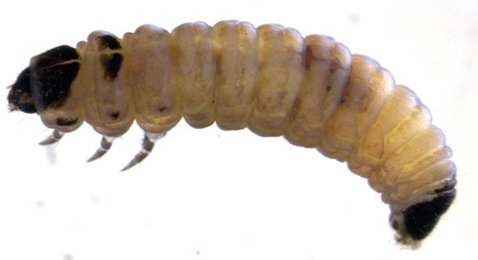 Coleophora violacea larva, lateral Image: © Willem Ellis (Bladmineerders van Europa) |
|
Coleophora violacea (Ström, 1783) [Lepidoptera: Coleophoridae]. |
3a > Leaf-miner: Egg well visible, on the upper surface (contary to Metallus pumilus). The mine is a large, transparant, upper-surface blotch, yellowish green at first, brownish later. Silk is deposited in the mine, but the quantity is too little to influence its colour; also the mine does not contract, like in C. marginea. All frass is ejected through a small opening in the underside of the mine. Pupation takes place after hibernation, within the mine; pupa not in a cocoon. |
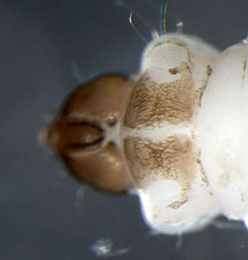 Coptotriche heinemanni larva, dorsal Image: © Willem Ellis (Bladmineerders van Europa) |
|
Coptotriche heinemanni (Wocke, 1871) [Lepidoptera: Tischeriidae]. |
| 3b > Leaf-miner: A gallery leading to whitish blotch. The larvae from the autumn generation feed throughout the winter. Pupation occurs inside the mine. Mines in shaded places can be large. Oviposition at the upperside of the leaf. From there runs a short corridor that widens into a long-elliptic blotch. The blotch is upper-surface, whitish to yellow-brown; the larva lines the inside with much silk, causing the mine to pucker slightly. All frass is ejected through a small opening in the underside of the mine. Pupation within the mine; the pupa is not enclosed in a cocoon. |
|
Coptotriche marginea (Haworth, 1828) [Lepidoptera: Tischeriidae]. |
3c > Leaf-miner: A gallery filled with frass, leading to blotch. The mined area is purple-stained. Egg at the upperside of the leaf, next to a major vein. The first part of the mine is a narrow corridor, largely filled with frass, following a vein and then making a hairpin turn. The corridor widens into an elongate blotch with dispersed black frass in the base or along the sides. Generally the leaf around the mine is intensely coloured wine red over a large area, making the mines very conspicuous. |
|
Ectoedemia erythrogenella (Joannis, 1908) [Lepidoptera: Nepticulidae]. |
3d > Leaf-miner: A contorted gallery with dispersed frass, leading to a blotch. Egg at the underside of the leaf. The mine is a highly contorted gallery, strongly widening towards the end. Frass in the second half of the gallery dispersed. The larva mines venter upwards. Mostly several mines in a leaf. |
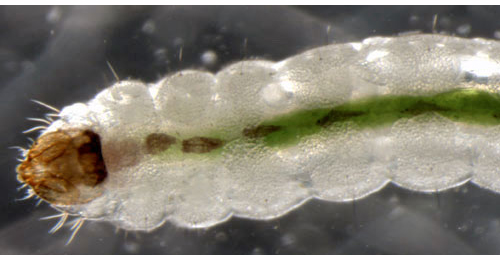 Ectoedemia rubivora larva, ventral Image: © Willem Ellis (Bladmineerders van Europa) |
|
Ectoedemia rubivora (Wocke, 1860) [Lepidoptera: Nepticulidae]. |
3e > Leaf-miner: Full depth transparent blotch without a clear preceding corridor, quickly and strongly widening from the start. Frass in sausage-shaped granules. Often several leaflets of a composite leaf each have a mine. The larvae of sawflies have at least six thoracic legs (although they may be reduced or absent), a head capsule and chewing mouthparts with opposable mandibles but no abdominal legs. |
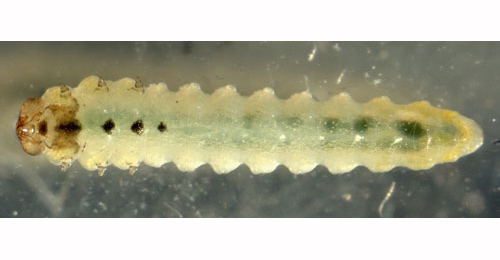 Fenella nigrita larva Image: © Willem Ellis (Bladmineerders van Europa) |
|
Fenella nigrita Westwood, 1839 [Hymenoptera: Tenthredinidae]. |
3f > Leaf-miner: Oviposition by way of an ovipositor, no egg visible therefore. The larva makes an irregular blotch. The part of the mine nearest to the oviposition site is more thranslucent than the later, in transparancy more greenish, part of the mine. The mine usually lies close to the leaf tip, often several together. After its first moult the larva makes a roundish excision, 3-4 mm in diameter. Incurvaria larvae, while resting, take a horse-shoe like posture, unlike the larvae of Antispila species. Sandwiched herein it drops to the ground and continues feeding of dead leaves. The excision occupies about half of the surface of the blotch. The mine is also described in. |
|
Incurvaria oehlmanniella (Hübner, 1796) [Lepidoptera: Incurvariidae]. |
3g > Leaf-miner and case-bearer: Small (less than 1 cm), full depth blotch, transparent when fresh, starting at the leaf margin, usually near the leaf tip; frass in scattered grains. The larva makes an elliptic double sided excision to form a case. Subsequently, it continues feeding within the case. |
|
Incurvaria praetella (Denis & Schiffermüller, 1775) [Lepidoptera: Incurvariidae. |
3f > Leaf-miner: The initial mine is usually in the form of a gallery, which expands to form a blotch.. Large, almost full depth blotch with scattered frass. The mine is identical to that of M. pumilus, but the larva is different. |
|
Metallus albipes (Cameron, 1875) [Hymenoptera: Tenthredinidae]. |
3g > Leaf-miner: No visible egg; it is deposited below the upper epidermis, generally close to a major vein. Fom there begins a short, quickly widening corridor that contains much frass, especially in its first part. The corridor opens into a large, very transparent, almost full depth blotch that often over runs the initial corridor. Frass in loose grains, larger as the larva increases in size. The frass is dry, and in old mines it may accumulate like pepper grains in the lowest part. Larva solitary, belly-up in the mine. The larvae of sawflies have at least six thoracic legs (although they may be reduced or absent), a head capsule and chewing mouthparts with opposable mandibles but no abdominal legs. |
|
Metallus pumilus (Klug, 1816) [Hymenoptera: Tenthredinidae]. |
3h > Leaf-miner: A long gallery with dispersed frass. Oviposition may be at either side of the leaf, not necessarily close to a vein. The mine is a not very tortuous corridor, not widened in the end. Frass in a broad central line. The mine strongly overlaps with the one of S. splendidissimella. |
|
Stigmella aurella (Fabricius, 1775) [Lepidoptera: Nepticulidae]. |
3i >Leaf-miner: A short, twisting irregular gallery with frass filling two-thirds of its width. In exposed leaves the frass is densely packed, whereas in shaded leaves it is thinner. It usually forms distinct dark brown mines, darker than S. aurella and the gallery edges are more conspicuously purple. Egg on the leaf upperside. The mine is an unusually short, not very tortuous corridor with a central line of frass that is irregularly interrupted and takes about 2/3 of the corridor width. Pupation external. |
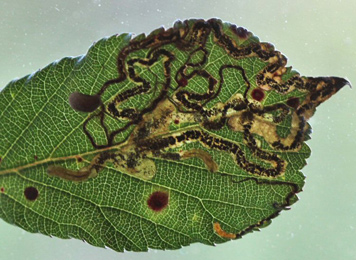 Mine of Stigmella auromarginella on Rubus fructicosus agg. Image: © Tony Davis (British leafminers) |
|
Stigmella auromarginella (Richardson, 1890) [Lepidoptera: Nepticulidae]. |
3j > Leaf-miner: A gallery following the leaf-edge. Egg generally at the upperside of the leaf, on a vein. The mine is a short corridor, no longer than 3 cm. Its first part is narrow and tends to follow a vein. The second part is rather tortuous and considerably widened, and often forms a secondary blotch. Generally only one mine in a leaf. Mines cannot reliably been distinguished from those of anomalella and centifoliella. |
|
Stigmella poterii (Stainton, 1857) [Lepidoptera: Nepticulidae]. |
3k > Leaf-miner: The initial gallery has frass in an interupted black line. Egg usually at the upperside of the leaf. The mine is a long, strongly vein-determined corridor. In the first part the frass lies in a rather narrow, often interrupted central line; further on the frass line is broader and more diffuse. Frequently more than one mine in a leaf. |
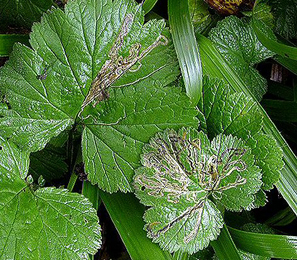 Mines of Stigmella pretiosa on Geum Image: © Duncan Williams (British leafminers) |
|
Stigmella pretiosa (Heinemann, 1862) [Lepidoptera: Nepticulidae]. |
3l > Leaf-miner: A long sinuous gallery with narrow frass-line. Oviposition generally at the leaf upper side, not especially close to a vein. From there a long and slender corridor starts, with frass usually in a narrow central line. The corridor often crosses itself, but rarely a thick vein. |
|
Stigmella splendidissimella (Herrich-Schäffer, 1855) [Lepidoptera: Nepticulidae]. |
| Last updated 07-Jul-2019 Brian Pitkin | ||
